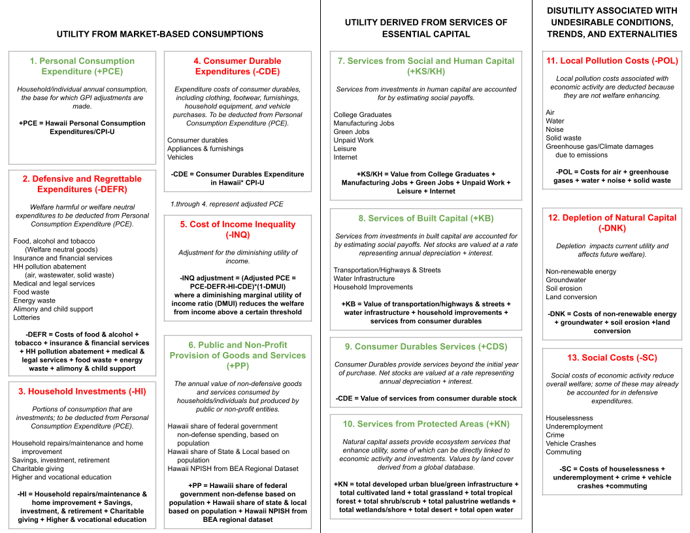HAWAII GENUINE PROGRESS INDICATOR (HI GPI)-CALCULATING HI GPI
Calculating HI GPI
Hawai’i GPI Indicator Descriptions
Indicators colored green are added to GPI and red are subtracted from GPI
GPI = U(PCE_ADJ + PP + KB + KS + KH – SC + KN – POL – DKN)
where PCE_ADJ = (PCE – DEFR – HI – CDE)*INQ
HI GPI formula and calculation in plain language: Hawai’i’s Genuine Progress Indicator (HI GPI) is a measure totaling the positive and negative impacts (Utility (U) or welfare) of market activity on the economy, society and environment. The calculation starts with Adjusted Personal Consumption Expenditure (PCE_ADJ) which consists of the Personal Consumption Expenditure (PCE) minus Defensive and Regrettable Consumption Expenditures (-DEFR)*, Household Investments (-HI) for household repairs/maintenance & home improvement, savings, investment & retirement, charitable giving and higher & vocational education, since these investments will be added as services from human (+KH), social (+KS) and built capital (+KB) later. Similarly, Consumer Durables Expenditures (-CDE) are subtracted and added back as Consumer Durables Services (+CDS) within built capital (+KN) later, adjust this portion for income inequality. Now with Adjusted PCE (+PCE_ADJ) determined, then add the Public and Non-Public Provision of Goods and Services (+PP), services from Social (+KS), Human (+KH), Built (+KB), and Natural Capital (KN). Finally, remove Pollution Costs (-POL), Depletion of Natural Capital (-DKN) and Social Costs (-SC).
*Defensive and Regrettable Expenditures (DEFR) are backed out since these have zero or negative welfare effects.
Data Sources: State of Hawaiʻi Data Book, U.S. Census Bureau, U.S. Bureau of Labor Statistics (BLS), Bureau of Economic Analysis – U.S. Department of Commerce (BEA), Bureau of Transportation Statistics – U.S. Department of Transportation, Office of Solid Waste Management Annual Reports – State of Hawaiʻi Department of Health, National Oceanic and Atmospheric Administration (NOAA) Coastal Change Analysis Program (CCAP) and National Fish Habitat Risk Assessment, U.S. Geological Survey – Department of the Interior National Gap Analysis Program’s Protected Area’s Database PAD-US, U.S. Environmental Protection Agency (EPA) -Ecosystem Services Valuation Database (ESVD) and National Emissions Inventory (NEI), U.S. Energy Information Administration State Energy Data System (EIA SEDS), U.S. Department of Housing and Urban Development Continuum of Care Homeless Populations and Subpopulations Report, Department of Justice Federal Bureau of Investigations (FBI) Uniform Crime Reports Trend Series, National Highways Transportation Safety Administration (NHTSA) and Fatality Analysis Reporting System (FARS), General Services Administration (GSA)
Report
Hawaiʻi’s Genuine Progress Indicator (GPI) Report 2022
HI GPI Calculation Excel Table
